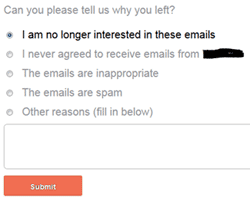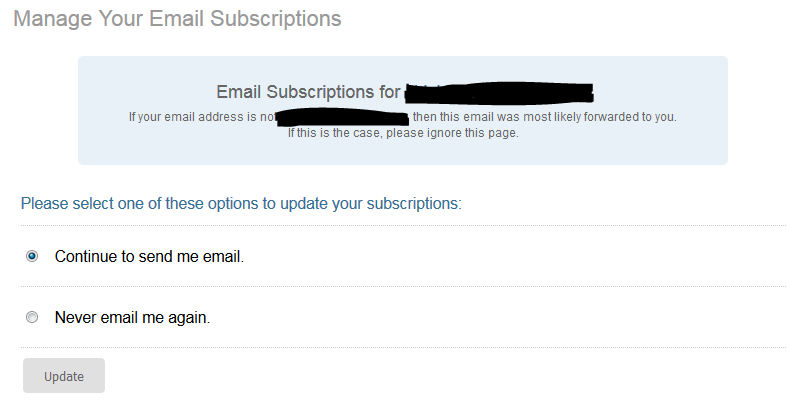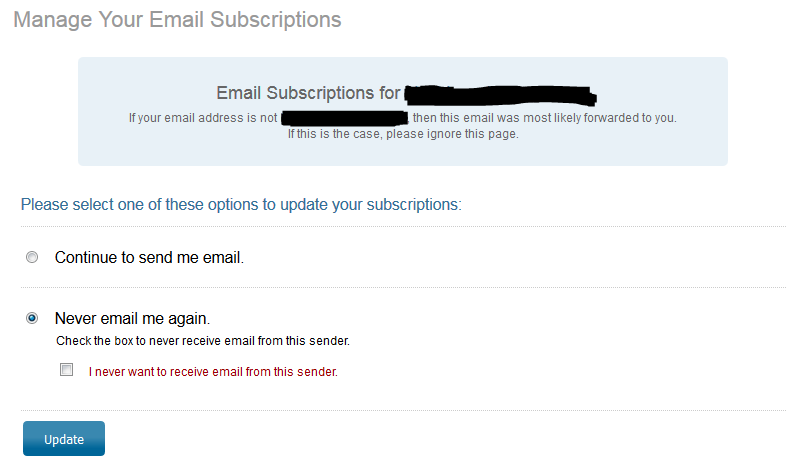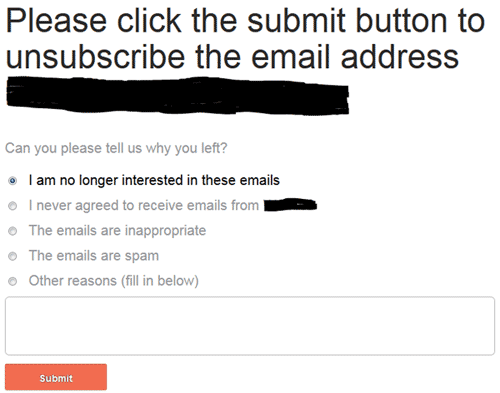A Tale of Two Emails
 I unsubscribed from two email lists today. The very different experiences that I had offer an object lesson in how to treat subscribers—and how not to treat them.
I unsubscribed from two email lists today. The very different experiences that I had offer an object lesson in how to treat subscribers—and how not to treat them.
In the first instance, I clicked the unsubscribe link at the bottom of an email newsletter from a company with which I’m not particularly familiar. I’m not sure how I got on their email list, but I can imagine. They work in an area that relates to my job but isn’t key to what I need to do, so it’s quite possible that I downloaded a white paper or attended a webinar that they sponsored at some point. I might have given them permission to email me, and I didn’t think they were sending me spam. But I wasn’t finding value in their emails, and I’m a busy person, so…unsubscribe.
What I expected to have happen at this point was one of two things:- I would be presented immediately with a web page confirming that I had been unsubscribed and offering me a path to re-subscribe if I didn’t mean to quit the list.
- I would be shown a web page telling me that I had clicked the unsubscribe link and asking me to confirm that was what I wanted to do, in which case I would click to confirm and be shown the confirmation page indicating I had done so.
Instead, I got this:

I can hardly count the problems with this page, but let me try:
- Although I got to this page by clicking an “Unsubscribe” link, the option to continue receiving email is pre-checked. It’s as if they’re trying to trick me into staying. The best user experience to offer in this situation would be to pre-check the unsubscribe option; I’ve already indicated that is my preference, and I would appreciate an acknowledgment of that. But if they’re unwilling to do that, then at a minimum they should not pre-check anything.
- The heading on the page says “Manage Your Email Subscriptions” but I’m not really able to manage anything. Managing email subscriptions generally involves choosing which types of email you want to receive, how often you want to receive them, and/or in what format (text vs. HTML). Simply turning a switch from “On” to “Off” doesn’t constitute managing subscriptions.
- The language on the page is unnecessarily harsh. I’ve already indicated that I don’t want this company to continue sending me the email I was receiving. But “Never email me again?” I’m not entirely sure that’s what I want; what I want is to be removed from this newsletter list. If I were offered a less stringent option—perhaps something like “Please remove me from this list” or “Stop sending me the X newsletter”—I could accomplish my goal of unsubscribing while letting the company retain the ability to send me a different type of email in the future. For example, if they initially got my email through a webinar sign-up, they might still be able to send me other webinar invitations. But since these are my only options, I choose “Never email me again.”
- I hit “Update,” and it doesn’t update my subscription.
Huh? “Update” doesn’t update anything? No, it doesn’t. Here’s what I was shown when I clicked “Update” to confirm that I really did want to unsubscribe:
 Fail.
Fail.
Let me tell you, this was the point at which I sincerely did want them to “Never email me again.” So…yeah, I checked the box and confirmed my wish yet again, and finally—finally—I got the confirmation page.
Contrast this experience with what happened later this morning when I unsubscribed from another enewsletter. In this instance, I was not unsubscribing because I don’t want the company’s emails, but because I had been receiving their newsletter at two different email addresses. I just wanted to cancel the emails to one address and end the duplication.
Again, I clicked the “Unsubscribe” link at the bottom of the email. Here’s what I was shown:

Oh, happy day:
- This acknowledges that I asked to unsubscribe, even while requiring me to confirm the action before it’s finalized.
- It asks me why I’m unsubscribing. This is valuable feedback for the email marketer to understand why people are leaving the list.
- The free-text “Other reasons” box allows me to tell the sender that I’m just ending duplication of a newsletter that I still find valuable when sent to my other email address.
- When I clicked “Submit” on this page, it really did submit and cancel my subscription.
Why your unsubscribe process should be a good one
Why should you bother to build a good experience for people who are quitting your email list? Aside from the Golden Rule, consider these reasons:
- You might have a chance to win the subscriber back someday. That’s a lot more likely to happen if their last impression of you is a good one.
- They might actually still be interested in receiving your emails, but you risk angering them if you don’t treat them well. Consider the second scenario above, in which I still wanted to receive the company’s newsletter at a different email address. If my experience had been anything like the failure I experienced in the first scenario, it’s quite possible that I would have dropped the email from both my addresses. Also consider the possibility that I might have clicked “unsubscribe” accidentally. A good confirmation page would let me know what I had done and give me a path to rectify my mistake by re-subscribing. But if you ticked me off during the unsubscribe process, you lost some of my respect and good will, and made me more likely to quit your list completely.
- If the subscriber doesn’t want to read your emails, you don’t want them on your list. They’re going to drag down your open rates, which will increase your chances of having your mail land in people’s junk folders and ultimately could hurt your website in search rankings as well. Also, If you’re paying for an email marketing platform, you’re almost certainly paying based on the number of emails you send; so each person on your list costs you a small amount of money, which is just plain wasted on someone who has no interest in receiving your messages.
Have you had bad unsubscribe experiences? Did they leave you with a bad impression of the company/website you were dealing with? You bet they did. I urge you to make every interaction with customers, contacts, email subscriber and website visitors the best experience possible. Always strive to make a good impression—even if it’s going to be your last contact with someone.

Clicking unsubscribe is like playing Rusian roulette. Generally, you never know what’s going to happen but you anticipate the worst. You are right. Companies that get it right, and then follow through with your request, leave you with a positive impression benefits both user and the company.